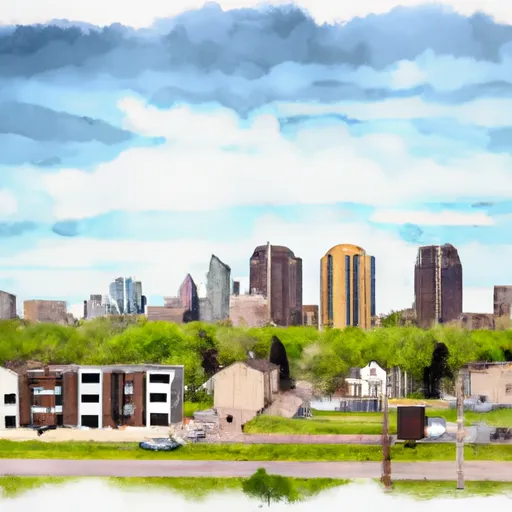-
 Snoflo Premium
Snoflo Premium
Get unlimited access to all our content
With no Ad interruptions! - Start Your Free Trial Login with existing account
Wanda
Eden Index
Climate
6.4
•
Recreation
0.3
•
Community
•
Safeguard
2.7/10

Wanda, Minnesota is a small rural town located in Redwood County in the southwestern region of the state. The climate in Wanda is classified as humid continental, characterized by hot summers and cold winters. Average temperatures range from the mid-80s (°F) in the summer to the mid-20s (°F) in the winter. Precipitation is fairly evenly distributed throughout the year, with an average annual rainfall of around 30 inches.
Hydrologically, Wanda is situated near the Minnesota River, which provides a significant water source for the region. The area is also dotted with numerous lakes, ponds, and wetlands, contributing to the local hydrology. These water bodies offer opportunities for fishing, boating, and wildlife viewing.
Outdoor recreation is a significant part of life in Wanda. The town is surrounded by picturesque countryside, making it an ideal destination for hiking, biking, and camping. The nearby Minnesota River Valley offers scenic trails for exploration, while the local lakes provide opportunities for swimming and picnicking. Moreover, hunters can engage in activities such as deer and pheasant hunting during the appropriate seasons. Overall, Wanda, Minnesota is a charming town that offers a pleasant climate, diverse hydrology, and ample outdoor recreation opportunities for residents and visitors alike.
What is the Eden Index?
The Snoflo Eden Index serves as a comprehensive rating system for regions, evaluating their desirability through a holistic assessment of climate health, outdoor recreation opportunities, and natural disaster risk, acknowledging the profound impact of these factors on livability and well-being.
Climate Health Indicator (CHI): 6.4
Wanda receives approximately
706mm of rain per year,
with humidity levels near 82%
and air temperatures averaging around
7°C.
Wanda has a plant hardyness factor of
4, meaning
plants and agriculture in this region thrive during a short period during spring and early summer. Most
plants will die off during the colder winter months.
By considering the ideal temperature range, reliable water supplies, clean air, and stable seasonal rain or snowpacks, the Climate Health Indicator (CHI) underscores the significance of a healthy climate as the foundation for quality living.
A healthy climate is paramount for ensuring a high quality of life and livability in a region, fostering both physical well-being and environmental harmony. This can be characterized by ideal temperatures, reliable access to water supplies, clean air, and consistent seasonal rain or snowpacks.
Weather Forecast
Streamflow Conditions
Minnesota
Area Rivers
Minnesota
Snowpack Depths
Minnesota
Reservoir Storage Capacity
Minnesota
Groundwater Levels
Recreational Opportunity Index (ROI): 0.3
The Recreational Opportunity Index (ROI) recognizes the value of outdoor recreational options, such as parks, hiking trails, camping sites, and fishing spots, while acknowledging that climate plays a pivotal role in ensuring the comfort and consistency of these experiences.
Access to outdoor recreational opportunities, encompassing activities such as parks, hiking, camping, and fishing, is crucial for overall well-being, and the climate plays a pivotal role in enabling and enhancing these experiences, ensuring that individuals can engage in nature-based activities comfortably and consistently.
Camping Areas
| Campground | Campsites | Reservations | Toilets | Showers | Elevation |
|---|---|---|---|---|---|
| Beaver Falls Co Park | None | 869 ft | |||
| Sunnybrook Park | 38 | 1,343 ft | |||
| Memorial Park - Olivia | 6 | 1,071 ft | |||
| Alexander Ramsey Park | 31 | 1,019 ft | |||
| Sailors and Soldiers Memorial Park | 24 | 1,035 ft | |||
| Bertha City Park | None | 1,400 ft |
Nearby Fishing
Catastrophe Safeguard Index (CSI):
The Catastrophe Safeguard Index (CSI) recognizes that natural disaster risk, encompassing floods, fires, hurricanes, and tornadoes, can drastically affect safety and the overall appeal of an area.
The level of natural disaster risk in a region significantly affects safety and the overall livability, with climate change amplifying these risks by potentially increasing the frequency and intensity of events like floods, fires, hurricanes, and tornadoes, thereby posing substantial challenges to community resilience and well-being.
Community Resilience Indicator (CRI):
The Community Resilience Indicator (CRI) recognizes that education, healthcare, and socioeconomics are crucial to the well-being of a region. The CRI acknowledges the profound impact of these elements on residents' overall quality of life. By evaluating educational resources, healthcare accessibility, and economic inclusivity, the index captures the essential aspects that contribute to a thriving community, fostering resident satisfaction, equity, and social cohesion.

